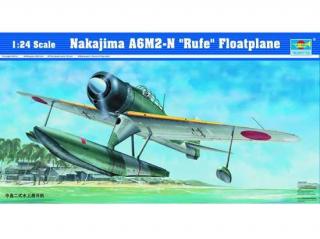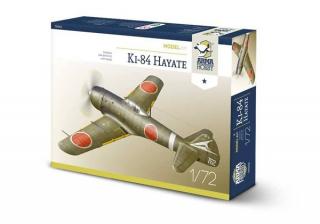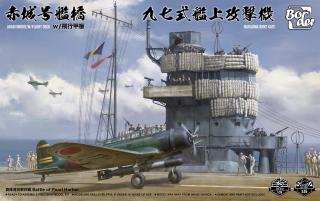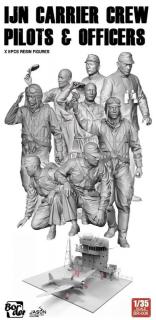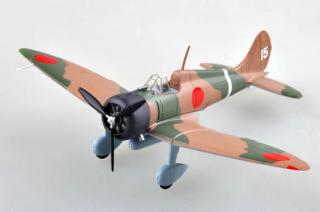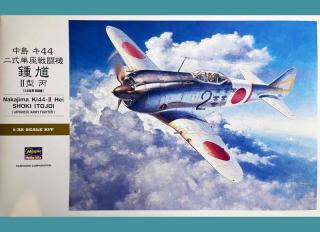
Nakajima Ki44-II Hei SHOKI (TOJO)
The Nakajima Type 2 "Shoki" was a single-seater fighter used by the Imperial Japanese Army Air Force (IAAF) during the Second World War. The origins of the design line in the IAAF's high degree of research interest in heavy fighter designs in the late 1930s. In late 1938, the IAAF commissioned the Nakajima Aircraft Company to begin research on a heavy fighter design concept putting an emphasis on speed, with armament consisting of a single cannon and two smaller caliber machine guns. On June 2, 1939, the IJAAF gave Nakajima a formal contract to build a prototype, with design specs calling for a top speed of 600 km/h at 4,000 meters, a climb rate of five minutes to 5,000 meters, an operational radius of 600 kilometers, and armament consisting of two 7.7mm and two 12.7mm machine guns - specs intended to equal or surpass those of any other air force's fighter designs in the world at the time. One problematic area during the design process, however, was the engine. At the time, there were no small-sized, high horsepower engines available to the Japanese military. Therefore, Nakajima provided its design with the power called for in specs by building an airframe around the Ha-41 - a 1,250hp radial engine with a huge frontal surface. Spec emphasis on high speed resulted in the design being fitted with small, thin main wings, one unfortunate consequence of which was a very high landing speed. As a countermeasure, Nakajima fitted the wings with what its designers referred to as "butterfly" flaps - a type of Fowler flap that could drop to a maximum of 45 degrees for landings, and could be deployed as combat flaps with 15 to 20 degree extension from a switch on the pilot's control column. Nevertheless, even with the butterfly flaps, take-offs and landings in the aircraft were problematic. Fixed armament for the prototype consisted of two Type 89 7.7mm machine guns fitted in the cowling, and one Type 1 12.7mm machine gun fitted in each main wing. Given the official IJAAF nomenclature of Ki-44, the prototype was completed on August 1940, but the aircraft did not meet specs in its initial testing. Fitting with cowling cooling flaps and tweaking of shapes of the cowling and various air intakes saw the maximum speed rise to 626 km/h. The design was officially adopted as the Ki-44 Type 2 single-seat fighter in February 1942. Aircraft through production number 152 were referred to as the Model I, with subsequent production models fitted with the more powerful Ha-109 engine officially adopted as the Model II in December 1942. The Model II had Koh, Otsu and Hei variants, depending on respective fixed armament configurations. The Koh-variant had the original Model I configuration of two Type 89 7.7mm machine guns in the cowling and one Ho-103 Type 1 12.7mm machine gun in each wing. Fitted with telescope-type gun sights, 353 Koh-variants were produced. 393 Otsu-variants were built, with two Ho-103 machine guns fitted in the cowling, and main wing guns removed and replaced with launch rails for Ho-301 40mm rockets. The Hei-variant - the most heavily produced Ki-44 variant - saw Ho-103 machine guns in all four gun stations, cowling and main wings, and upgrade of the earlier telescopic gunsight to a more modern optical type.DATA (Type 2 Model II, Hei) Crew: 1; Length: 8.843m; Wingspan: 9.448m; Height: 3.248m; Max gross weight: 2,764kg; Wing area: 15.00m°; Max speed: 605km/h @ 5,200m; Cruise speed: 400km/h @ 4,000m; Engine: HA-109 1,520hp; Weapons: 12.7mm machine guns X2 (cowling); 12.7mm machine guns X2 (wings); Bomb load: 30 - 100kg X 2
- Sklep: Sklep Modelarski, Modelarstwo, Modele do Sklejania - FlyModel / Gomix
- Kategoria: Główna/Modele plastikowe/Samoloty
- Marka: Hasegawa
- Dostępność: na stanie
- Zaktualizowany: 10.7.2024
- Cena: 250.00 zł

